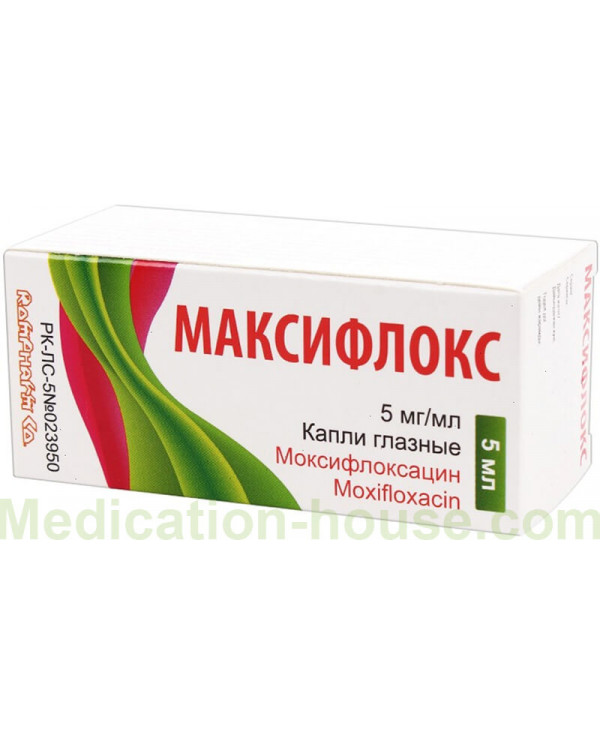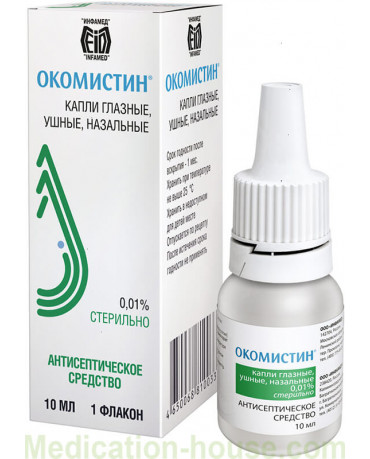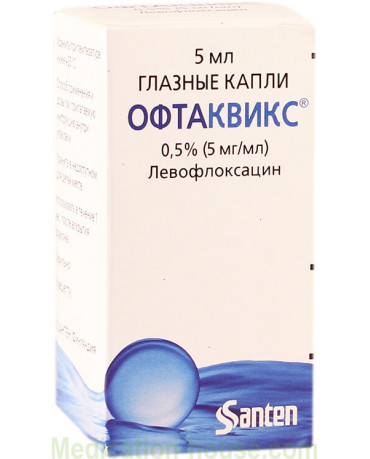Maxiflox instruction
You can buy Maxiflox here
Composition, form, packaging of medicine
Maxiflox is a medicinal solution of a yellow-greenish tint without a pronounced odor. The therapeutic effect of the drops is developed on the antibiotic moxifloxacin. 1 ml of solution accounts for 5.45 mg of moxifloxacin hydrochloride. The composition of the medicine is supplemented with the following components:
sodium chloride;
orthoboric acid;
purified water.
There is also a 1 M hydrochloric acid solution or / and 1 M sodium hydroxide solution to pH = 6.7-7.0.
The drug is packaged in convenient 5 ml polyethylene dropper bottles. Each pack of cardboard contains one tube, a leaflet with the characteristics of the medication.
Produced by Maxiflox pharmaceutical company from Romania S.C. ROMPHARM Company, S.R.L.
Medicinal qualities
Drops for eyes Maxiflox is an antibacterial drug of the IV generation group of fluoroquinolones for topical use in ophthalmology. The therapeutic effect of the drug is due to the antimicrobial activity of the active ingredient. The mechanism of action of moxifloxacin is complex and consists of two stages:
inhibition of bacterial enzymes topoisomerase II (DNA gyrase) and topoisomerase IV;
subsequent violation of its synthesis, leading to cell death.
As a result, bacteria cannot fully reproduce and die faster, as their cells stop dividing. In the course of research, it was found that moxifloxacin is active against gram-positive and gram-negative bacteria, anaerobes, atypical and acid-fast microorganisms.
After instillation of the maximum allowable dose (1 drop 3 times a day), the penetration of the drug components into the systemic circulation is recorded. The half-life is 12-13 hours.
Basic indications
Bacterial conjunctivitis is a direct indication for the appointment of ophthalmic drops. The disease is very serious. If you do not start timely treatment, it quickly becomes chronic. Pathology can develop when the organ of vision is infected with various bacteria. Typically, pathogens are sensitive to moxifloxacin.
Also, the therapeutic solution can be used for blepharitis, keratitis, barley, meibomitis, dacryocystitis (in complex therapy), ulcers and wounds on the cornea.
Contraindications
Maxiflox eye drops should not be used for therapy in the presence of the following conditions:
high sensitivity to antibacterial agents of the fluoroquinolone series;
individual intolerance to at least one component of the drops;
children's age up to 1 year.
It is allowed to use the drug during the period of gestation and breastfeeding. It should be prescribed only by a specialist after a thorough examination of the woman, an assessment of the potential risk and benefits of using drops. But it should be borne in mind that there is no sufficient experience in using the drug during pregnancy and during breastfeeding.
Method of application and doses
Maxiflox drops are intended for topical use only, i.e. for instillation into the conjunctivitis sac. Not intended for use as subconjunctival injection or for injection into the anterior chamber of the eye.
The official instructions for use indicate the following standard dosage: 1 drop 3 times a day - for adults and children over a year old.
In most patients, improvements are recorded after 3-5 days. To consolidate the therapeutic effect, treatment is continued for another 2-3 days.
To minimize the penetration of the antibacterial agent into the systemic circulation, after instillation, the nasolacrimal canal is pressed with a finger for several minutes. Instillation should be carried out carefully, without touching the mucous membrane and other surfaces with the dropper. This will help avoid contamination of the sterile solution.
Adverse reactions, overdose
Undesirable consequences are often recorded on the part of the organ of vision. A person may be disturbed by the following unpleasant signs:
dry eye syndrome;
pain and pain in the eyes;
burning, redness, itching;
foreign body sensation;
photophobia, lacrimation.
Lens clouding, increased intraocular pressure, secondary infection, corneal defects, allergic manifestations, purulent departments are more serious side effects, the frequency of which has not been established.
Possible side effects from other organs and systems:
heart palpitations;
feeling short of breath;
dyspnea;
pain in the nasopharynx;
skin rashes;
vomiting, nausea, joint pain.
The concentration of the antibiotic in the solution is insignificant, so an overdose is unlikely. It is also not observed if the medicated liquid is accidentally swallowed.
Special information, interaction
Studies aimed at studying the interaction of Maxiflox drops with other drugs have not been conducted. Most likely, interaction is unlikely, since the medicine is used only topically.
Other recommendations that should be read before starting therapy:
Patients under 18 years of age and over 65 years of age do not require dosage adjustment. Also, the dosage regimen is not revised if the patient has renal or hepatic insufficiency.
If the condition does not improve after 5 days from the start of therapy, you should consult a doctor. Most likely, he will reconsider the diagnosis and select a different drug.
If several topical ophthalmic drugs are prescribed, then the interval between their use should be at least 15 minutes. Eye ointments are applied last.
If you experience severe allergic reactions (anaphylactic shock, laryngeal edema, urticaria, anaphylaxis), you need to call a doctor. Immediate resuscitation may be required.
During treatment, it is recommended to stop wearing contact lenses.
After instillation, vision may be temporarily blurred. Until the clarity of visual perception is restored, it is not recommended to drive a car and other mechanisms.
Additional information
The shelf life of a closed bottle with a solution is 3 years from the date of production. After opening, the medicine is usable within 30 days. Store the drug at room temperature in a shaded place where the sun's rays do not fall. The access of children and pets to drops is limited.
Reviews
Olga Sergeevna, 46 years old
I never buy medicines on my own, so the ophthalmologist prescribed Maxiflox for me. The drops were prescribed for acute conjunctivitis. The condition of the eyes was deplorable: swollen, red eyes with pus. All treatment lasted a week, dripping 1 drop 3 times a day. I felt the initial result after 3 instillations. Pus ceased to stand out, edema subsided. All symptoms disappeared after 4 days, but treatment continued. The drops are very good, no reactions or side effects. I recommend, but only according to the indications and prescription of an ophthalmologist.
Alina, 28 years old
Drops Maxiflox were prescribed by the doctor to my daughter (5 years old) in the complex treatment of conjunctivitis. The disease was very difficult, but with the help of drops it was possible to cure it completely. The child did not complain of any unpleasant sensations from the droplets. Recently, my husband's eye turned red, Maxiflox dripped. Within two days, the redness disappeared. In both cases, the drug proved to be very effective and safe. My reviews are only positive.
Lydia, 33 years old
I have known Maxiflox for a long time, since conjunctivitis is an eternal problem. The disease necessarily aggravates 2 times a year. I used a lot of tools, every time I was not satisfied with something. A familiar optometrist recommended these drops. I have been using only them for 2 years. For me, Maxiflox is a very comfortable remedy, there have never been any consequences. If conjunctivitis is not triggered, it goes away in 2 days. It is important to continue the treatment for several more days in order to consolidate the result.
Terms of sell
You don't need a prescription to buy Maxiflox.





